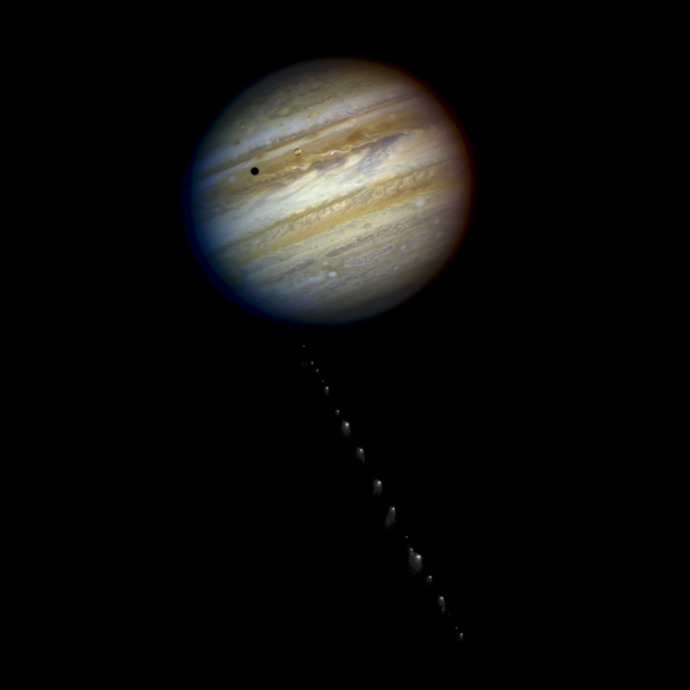Comet Shoemaker-Levy 9 created one of the most interesting spectacles that people have ever seen. A few months after the discovery, parts of the comet crashed into the planet Jupiter. The collision caused damage that is visible from Earth. In official sources, where NASA describes the comet, information appeared that this was the first collision of two bodies of the solar system, which scientists observed. The effects of the comet on the atmosphere of Jupiter were simply impressive and met expectations.
In the late 90s, Hollywood released two blockbusters: “Armageddon” and “Deep Blow” - on the subject of large objects that threaten the Earth. Following the release of these films, Congress allowed NASA to search for more near-Earth objects (OZOs) in order to better control those flying dangerously close to our planet. The comet that hit Jupiter in 1994 aroused fears of an asteroid collision with the Earth.
The first comet from the orbit of Jupiter
The comet was first noticed in March 1993 by three veterans in the field of discoveries of cosmic bodies: David Levy, Eugene and Carolyn Shoemaker. The group collaborated earlier and had already discovered several other comets, so this one was called Shoemaker-Levy 9. The March circular of the Central Bureau of Astronomical Telegrams contained a small reference to the position of the cosmic body. It was indicated that the comet is located at a distance of about 4 ° from Jupiter, and the movement implies its presence within the planet.

A few months later it turned out that the comet Shoemaker-Levy revolved around Jupiter, and not the Sun. Astronomer Steve Fantress suggested that the comet collapsed on July 7, 1992, when the planet hit it at an altitude of about 120,000 km above its atmosphere. Opinions are very different, and some believe that the comet passed at a distance of 15,000 km. It is likely that from the moment it fell under strong gravity in 1966, the comet has revolved around the planet for many decades.
Further orbital calculations showed that the comet actually crashed into the planet’s body in July 1994. The spacecraft Galileo, sent into orbit, was still on its way to the planet and could not get a close-up when the comet Shoemaker-Levy collided with Jupiter. However, observatories around the world turned their attention there, waiting for an impressive show. The Hubble Space Telescope was also used to observe this meeting.
Fireworks show
The collision of comet Shoemaker-Levy with Jupiter ended with the so-called fireworks. From July 16 to July 22, 1994, 21 separate comet fragments crashed in the atmosphere, leaving spots behind. Although all collisions took place on the side of Jupiter, facing away from the Earth, they occurred close to a place that soon came into the view of telescopes. This meant that astronomers saw the impact sites a few minutes after the event.

The bright surface of Jupiter was dotted with dots near the place where the comet pierced the atmosphere. Hubble astronomers were surprised to see sulfur-containing compounds such as hydrogen sulfide as well as ammonia as a result of the collision. A month after the collision, the plots faded noticeably, and scientists said that the atmosphere of Jupiter did not suffer irreversible changes from the effects of the strikes. NASA added that Hubble's ultraviolet observations show the movement of very thin particles of debris that are now suspended high in the atmosphere of Jupiter.
Ripple effect
The scars from the blows disappeared many years ago. But one group of scientists recently discovered a change in the environment of Jupiter due to a collision with comet Shoemaker-Levy. When the Galileo (spaceship) arrived, images were obtained with ripples in the main ring in the 1996s and 2000s. In addition, the entire ring was tilted in 1994 by about 2 kilometers after the impact.
In 2011, almost two decades after the impact, the New Horizons spacecraft associated with Pluto still detected irregularities in the ring, according to an article in the journal Science. Based on the observations of the European Space Observatory Herschel, the water from the impact of a comet was in the atmosphere of Jupiter even in 2013.
Policy changes
Political effects also surfaced decades after the discovery of the comet. For example, politicians tried to figure out how many large extraterrestrial objects remain invisible at Earth. Congress requested NASA to find at least 90% of the asteroids around the planet with a diameter of 0.62 miles (1 kilometer). As of 2011, NASA has discovered more than 90% of the largest asteroids, the agency said. A study using a broadband infrared probe suggested that there are fewer hiding asteroids near our planet than previously thought. However, most medium-sized asteroids have yet to be discovered.